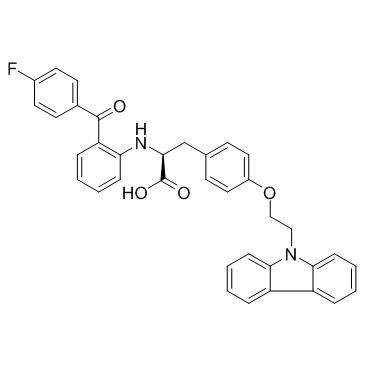Chiglitazar
Modify Date: 2024-01-01 21:42:40

Chiglitazar structure
|
Common Name | Chiglitazar | ||
|---|---|---|---|---|
| CAS Number | 743438-45-1 | Molecular Weight | 572.625 | |
| Density | 1.3±0.1 g/cm3 | Boiling Point | 779.8±60.0 °C at 760 mmHg | |
| Molecular Formula | C36H29FN2O4 | Melting Point | N/A | |
| MSDS | N/A | Flash Point | 425.4±32.9 °C | |
Use of ChiglitazarChiglitazar is a PPARα/γ dual agonist, with EC50s of 1.2, 0.08, 1.7 μM for PPARα, PPARγ and PPARδ, respectively. |
| Name | L-Tyrosine, O-[2-(9H-carbazol-9-yl)ethyl]-N-[2-(4-fluorobenzoyl)phenyl] |
|---|---|
| Synonym | More Synonyms |
| Description | Chiglitazar is a PPARα/γ dual agonist, with EC50s of 1.2, 0.08, 1.7 μM for PPARα, PPARγ and PPARδ, respectively. |
|---|---|
| Related Catalog | |
| Target |
PPARα:1.8 μM (EC50) PPARγ:0.08 μM (EC50) PPARδ:1.7 μM (EC50) |
| In Vitro | Comparative dose-response study of Chiglitazar is performed with rosiglitazone and pioglitazone for PPARγ, and WY14643 for PPARα. Chiglitazar shows significant activation of both the isoforms. Chiglitazar shows weaker PPARγ activating activity than rosiglitazone, but stronger than pioglitazone. In terms of PPARα activation, Chiglitazar shows more potent activity than rosiglitazone, pioglitazone, or WY14643 which is a selective PPARα agonist[1]. |
| In Vivo | After insulin injection, plasma glucose levels in the MSG rats treated with Chiglitazar or rosiglitazone are significantly reduced compared with the control group treated with vehicle at all time points. Fasting PI levels are lower in animals treated with Chiglitazar and rosiglitazone than control. The ISIs of MSG obese rats treated with chiglitazar and rosiglitazone are significantly higher than control. Furthermore, Chiglitazar ameliorates the HOMA indices. For IPGTT, at the 30 min after glucose loading, the glucose values in the 5 and 10 mg /kg Chiglitazar and rosiglitazone-treatment groups are significantly lower than those in the vehicle treatment group. The integrated for the glucose response during the IPGTT in the treatment groups are significantly less than those in the control groups[1]. |
| Animal Admin | Rats[1] MSG obese rats (6 months old) are sorted into five treatment groups (n=10 each, male and female in half) based on decreased blood glucose in the insulin tolerance test, glucose levels, blood total triglyceride (TG), total cholesterol (TCHO), and initial body weight. From the next day, MSG obese rats receive single daily oral treatment with Chiglitazar (5, 10, and 20 mg kg-1 day-1, respectively), rosiglitazone (5 mg kg-1 day-1) or vehicle (water, 0.05% Tween 80) for 40 days. Normal wistar rats (n=10) serve as a normal group are treated with vehicle[1]. |
| References |
| Density | 1.3±0.1 g/cm3 |
|---|---|
| Boiling Point | 779.8±60.0 °C at 760 mmHg |
| Molecular Formula | C36H29FN2O4 |
| Molecular Weight | 572.625 |
| Flash Point | 425.4±32.9 °C |
| Exact Mass | 572.211121 |
| PSA | 80.56000 |
| LogP | 8.72 |
| Vapour Pressure | 0.0±2.8 mmHg at 25°C |
| Index of Refraction | 1.637 |
| O-[2-(9H-Carbazol-9-yl)ethyl]-N-[2-(4-fluorobenzoyl)phenyl]tyrosine |
| Tyrosine, O-[2-(9H-carbazol-9-yl)ethyl]-N-[2-(4-fluorobenzoyl)phenyl]- |